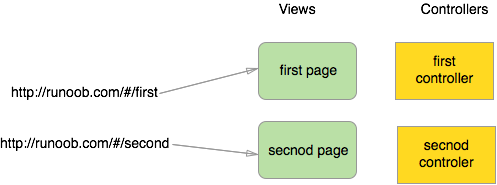AngularJS routing
In this chapter we will introduce AngularJS routing to you.
AngularJS routing allows us to access different content through different URLs.
A multi-view single page web application (single page web application, SPA) can be implemented through AngularJS.
Usually our URL format is http://php.cn/first/page, but in single-page web applications AngularJS is implemented through # + tag , For example:
http://php.cn/#/first http://php.cn/#/second http://php.cn/#/third
When we click on any of the above links, the address requested from the server is the same (http://php.cn/). Because the content after the # sign will be ignored by the browser when requesting the server. So we need to implement the functionality behind the # number on the client. AngularJS routing uses # + tag to help us distinguish different logical pages and bind different pages to the corresponding controllers.

In the above graphic, we can see that two URLs are created: /ShowOrders and /AddNewOrder. Each URL has a corresponding view and controller.
Next let’s look at a simple example:
Instance
<html>
<head>
<meta charset="utf-8">
<title>AngularJS 路由实例 - 菜鸟教程</title>
</head>
<body ng-app='routingDemoApp'>
<h2>AngularJS 路由应用</h2>
<ul>
<li><a href="#/">首页</a></li>
<li><a href="#/computers">电脑</a></li>
<li><a href="#/printers">打印机</a></li>
<li><a href="#/blabla">其他</a></li>
</ul>
<div ng-view></div>
<script src="//cdn.bootcss.com/angular.js/1.4.6/angular-animate.min.js"></script>
<script src="//cdn.bootcss.com/angular.js/1.3.13/angular-route.js"></script>
<script>
angular.module('routingDemoApp',['ngRoute'])
.config(['$routeProvider', function($routeProvider){
$routeProvider
.when('/',{template:'这是首页页面'})
.when('/computers',{template:'这是电脑分类页面'})
.when('/printers',{template:'这是打印机页面'})
.otherwise({redirectTo:'/'});
}]);
</script>
</body>
</html>Running Example»
Click the "Run Instance" button to view the online instance
Example analysis:
#1. Load the js file that implements routing: angular-route.js.
2. Contains the ngRoute module as a dependent module of the main application module.
angular.module('routingDemoApp',['ngRoute'])3. Use the ngView command.
<div ng-view></div>
The HTML content within this div will change according to the routing changes.
Configure $routeProvider, AngularJS $routeProvider is used to define routing rules.
module.config(['$routeProvider', function($routeProvider){ $routeProvider .when('/',{template:'这是首页页面'}) .when('/computers',{template:'这是电脑分类页面'}) .when('/printers',{template:'这是打印机页面'}) .otherwise({redirectTo:'/'}); }]);The config function of the AngularJS module is used to configure routing rules. By using configAPI, we request $routeProvider is injected into our configuration function and use $routeProvider.whenAPI to define our routing rules.
$routeProvider provides us with the when(path,object) & otherwise(object) function to define all routes in order. The function contains two parameters:
The first parameter is the URL or URL regular rule.
The second parameter is the routing configuration object.
The first parameter of the $routeProvider.when function is the URL or URL regular rule, and the second parameter is the routing configuration object.
Route setting object
AngularJS routing can also be implemented through different templates.
The routing configuration object syntax rules are as follows:
$routeProvider.when(url, {
template: string,
templateUrl: string,
controller: string, function 或 array,
controllerAs: string,
redirectTo: string, function,
resolve: object<key, function>
});Parameter description:
template:
If we only need to insert simple HTML content into ng-view, use this parameter:
.when('/computers',{template:'这是电脑分类页面'})templateUrl:
If we only need to insert the HTML template file in ng-view, use this parameter:
$routeProvider.when('/computers', { templateUrl: 'views/computers.html', });Above The code will get the contents of the views/computers.html file from the server and insert it into ng-view.
controller:
function, string or array type, in the current The controller function executed on the template generates a new scope.
controllerAs:
#string type, specifies an alias for the controller.
redirectTo:
The redirected address.
resolve:
Specify other modules that the current controller depends on.
- ##Instance
<html> <head> <meta http-equiv="content-type" content="text/html; charset=UTF-8"> <script src="http://apps.bdimg.com/libs/angular.js/1.4.6/angular.min.js"></script> <script src="http://apps.bdimg.com/libs/angular-route/1.3.13/angular-route.js"></script> <script type="text/javascript"> angular.module('ngRouteExample', ['ngRoute']) .controller('HomeController', function ($scope) { $scope.$route = $route;}) .controller('AboutController', function ($scope) { $scope.$route = $route;}) .config(function ($routeProvider) { $routeProvider. when('/home', { templateUrl: 'embedded.home.html', controller: 'HomeController' }). when('/about', { templateUrl: 'embedded.about.html', controller: 'AboutController' }). otherwise({ redirectTo: '/home' }); }); </script> </head> <body ng-app="ngRouteExample" class="ng-scope"> <script type="text/ng-template" id="embedded.home.html"> <h1> Home </h1> </script> <script type="text/ng-template" id="embedded.about.html"> <h1> About </h1> </script> <div> <div id="navigation"> <a href="#/home">Home</a> <a href="#/about">About</a> </div> <div ng-view=""> </div> </div> </body> </html>
Running Instance» Click the "Run Instance" button to view the online instance








